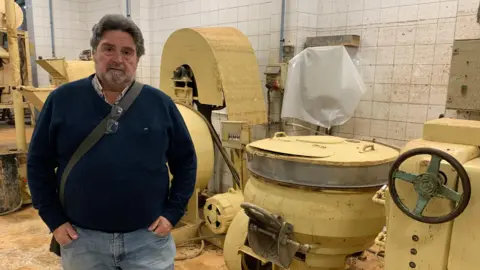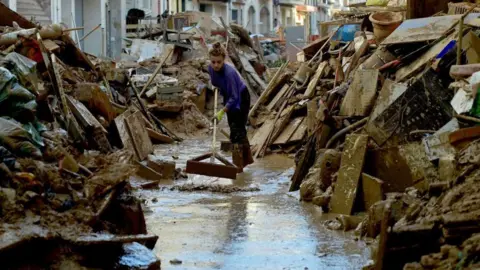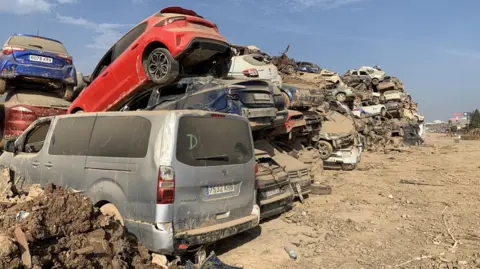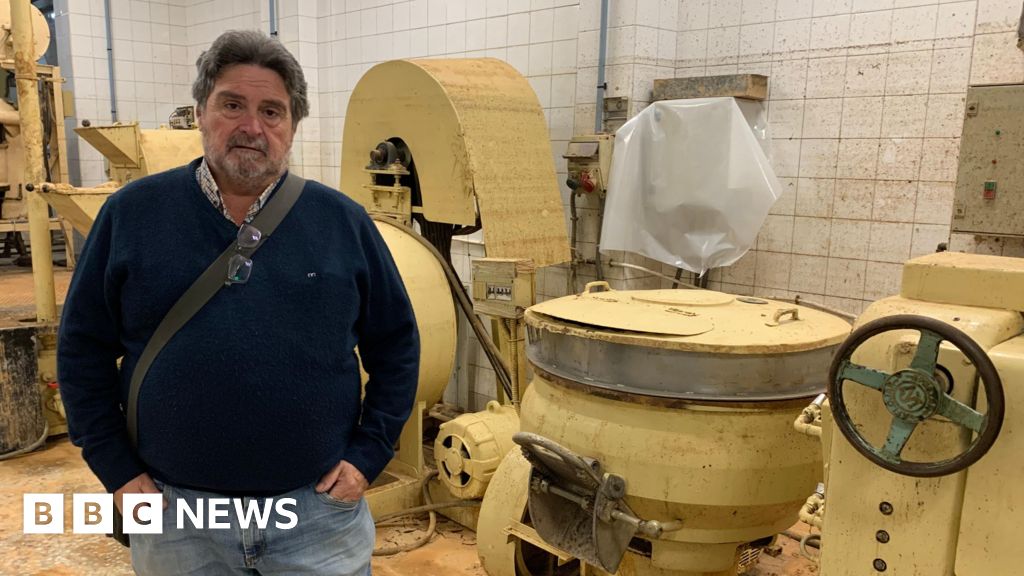 Guy Hedgecoe
Guy HedgecoePascual Andreu points proudly to a black-and-white photograph stuck to the wall of the premises of his chocolate-making business. Staring out from it is his grandfather, who started the company in 1914.
But, as he looks around him and remembers the destruction caused by the flash floods which struck the eastern Spanish region of Valencia on 29 October, tears well up in Andreu’s eyes.
“The water came in and water and mud covered everything,” he says. “And when it had gone, it left a terrible sight. All the stock we had was ruined, the machinery was useless.”
He adds: “All my life working. And for what?”
The floodwater left a six-feet-high (1.8m) mark on the wall, and although the water has now gone, mud still clings to the machines. Miraculously, the photo of his grandfather was not washed away.
But, now in his sixties, and still waiting to see how much insurance money he might receive, Andreu is too disheartened to start over.
The flash flood killed more than 220 people in the Valencia region, many of them caught in their cars, or on the ground floors of buildings when the tsunami-like waters hit. But as well as claiming lives, the disaster also devastated livelihoods. Valencia’s chamber of commerce estimated that 48,000 companies have been affected.
The towns and industrial belt surrounding the Mediterranean city of Valencia, which itself avoided the impact of the floods, were the worst hit. In total, the province of Valencia represents 5% of Spain’s GDP, according to CaixaBank Research, which estimates that the disaster could reduce national economic output by one to two percentage points in the fourth quarter of 2024.


Much of the damage has been caused on industrial estates. Diego Romá, executive president of the federation of industrial estates in the Valencia region (Feteval), says that “thousands and thousands of jobs are in the air” and that a total of 58 industrial estates were affected by the flood water.
“Most companies are working hard to resume production, but unfortunately there are maybe 10 to 20% of companies which are going to close,” he said.
The legacy of 29 October is still visible on the industrial estates. Abandoned cars sit on the side of the road covered in mud, debris has been pushed up against walls and the shutters of many businesses remain closed.
Electro Fernández, an electricity installation company, is one of the few which has reopened, having lost €40,000 ($42,000; £33,000) worth of tools in the floods.
“We were immediately affected 100% because we lost our tools and vehicles,” said Patricia Muñoz, who co-owns the company with her husband. She says that they are currently working at 10% of their capacity.
“We’ve cleaned the place, we’ve got all our employees here, and we’ve taken action to get going again,” she says. “But a lot of the companies on this industrial estate, and on others are nowhere near that, they are still cleaning up.
“This has been an absolute disaster. You only realise the scale of it when you see it for yourself.”
Not far away is a car storage area, where hundreds of the 120,000 or so vehicles damaged or destroyed by the flooding have been removed from roads and piled one on top of the other. As part of a €17bn relief plan announced by the government in the first month after the tragedy, it promised to provide up to 10,000 euros to car owners to replace their vehicles.
Businesses and self-employed workers are also due to benefit, with compensation for damage caused to homes and corporate premises. A furlough scheme is also in place.
The Socialist prime minister, Pedro Sánchez, told congress in late November that his government was “making a titanic effort” to ensure that the promised funds reach those in need as soon as possible. However, not everyone is convinced.
“I think that official financial aid is badly managed,” says Toni Milla, president of a local business association in the town of Alfafar, which was heavily affected. He says that a lot of the relief for businesses promised during the Covid pandemic did not reach its destination.
“I think this time the same thing is going to happen,” he says.


Valencians’ faith in their authorities has already been severely shaken by the immediate response to the disaster. Protesters have been demanding the resignation of regional president Carlos Mazón, who, it emerged, was absent from his office for several hours on the day the floods struck because he was having lunch with a journalist. Many believe his administration’s delay in issuing an alert to the phones of people in the region cost lives.
Mazón has rejected such claims. “We did the best we could with the information available,” he says.
Others criticise the central government for failing to deploy the military and other resources more forcefully. Sánchez, however, has insisted that his administration “fulfilled its duties and did so from the very beginning” of the crisis.
Meanwhile, help has been provided by the private sector. Alcem-se, a charity platform set up by local supermarket entrepreneur Juan Roig, says it has distributed €35m euros in non-refundable aid to 4,600 businesses.
However, for many, including Mr Milla, the relief may not be enough. He owned a local TV channel, an estate agency and a bar and he has only managed to reopen the latter – partially – in the wake of the October floods.
He lists several nearby businesses – including a petrol station, a gym, a beautician and an optician – which he says will not reopen.
But it is not just urban areas which were hit on 29 October. The Valencia region is part of an agricultural heartland in south-eastern Spain, which exports large quantities of fruit and vegetables to the rest of Europe.
Twenty-five miles (40km) south of Valencia city, José España visits his orange trees. Beneath them, oranges which were washed off their branches by the floodwater lie rotting on the ground.
“Farmers always say ‘next year things will get better’, but right now, the mood among farmers is very pessimistic,” he said. The agricultural association he is a member of, AVA-ASAJA, estimates that well over €1bn euros worth of damage was caused on 29 October to crops alone.
“Farmers have had a few years now in which we’ve been abandoned, and the floods might end up causing a few more farmers than usual to leave the industry,” he says. “In order to get things back to how they were before the flooding, it’s going to take two or three years.”


